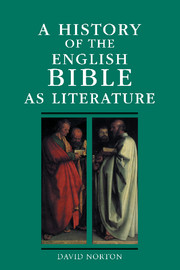Book contents
- Frontmatter
- Contents
- List of plates
- Preface
- List of abbreviations
- 1 Creators of English
- 2 From the Great Bible to the Rheims-Douai Bible: arguments about language
- 3 The King James Bible
- 4 Literary implications of Bible presentation
- 5 The struggle for acceptance
- 6 The Psalter in verse and poetry
- 7 ‘The eloquentest books in the world’
- 8 Writers and the Bible 1: Milton and Bunyan
- 9 The early eighteenth century and the King James Bible
- 10 Mid-century
- 11 The critical rise of the King James Bible
- 12 Writers and the Bible 2: the Romantics
- 13 Literary discussion to mid-Victorian times
- 14 The Revised Version
- 15 ‘The Bible as literature’
- 16 The later reputation of the King James Bible
- 17 The New English Bible
- Bibliography
- General Index
- Biblical Index
4 - Literary implications of Bible presentation
Published online by Cambridge University Press: 05 June 2012
- Frontmatter
- Contents
- List of plates
- Preface
- List of abbreviations
- 1 Creators of English
- 2 From the Great Bible to the Rheims-Douai Bible: arguments about language
- 3 The King James Bible
- 4 Literary implications of Bible presentation
- 5 The struggle for acceptance
- 6 The Psalter in verse and poetry
- 7 ‘The eloquentest books in the world’
- 8 Writers and the Bible 1: Milton and Bunyan
- 9 The early eighteenth century and the King James Bible
- 10 Mid-century
- 11 The critical rise of the King James Bible
- 12 Writers and the Bible 2: the Romantics
- 13 Literary discussion to mid-Victorian times
- 14 The Revised Version
- 15 ‘The Bible as literature’
- 16 The later reputation of the King James Bible
- 17 The New English Bible
- Bibliography
- General Index
- Biblical Index
Summary
PRESENTATIONS OF THE TEXT, 1525–1625
At all times there are probably more hearers than readers of the Bible. Sometimes they hear the incomprehensible sounds of a foreign language. Sometimes they hear brief extracts, often no more than a fragment of a verse, used as the basis of sermons, or as authorities in arguments or even as decorations for discourses. Sometimes they hear sustained readings, a chapter or more at a time, perhaps forming part of a methodical progress through the Bible. Sometimes also they hear parodies. The heard Bible, one may suggest, was best known as a fragmentary, interpreted thing, presented within some religious context. Further, it is likely that for many people in the period of the translators, rather as in the present century, the words of any particular text could vary from one hearing to the next. Not only were there alternative versions in print, but the educated, at least, were constantly producing their own translations or paraphrases of a verse as they cited it (see below, pp. 103 ff.). The people probably did not become familiar with a fixed form of words for any of the parts of the Bible. This would have been true even of that most popular part of the Bible, the Psalms. Though the Stern hold and Hopkins Psalter held sway, it gives many of the Psalms in two or three versions, and they might also be heard in the PB version and the differing versions of the Bible translations.
- Type
- Chapter
- Information
- A History of the English Bible as Literature , pp. 76 - 88Publisher: Cambridge University PressPrint publication year: 2000

